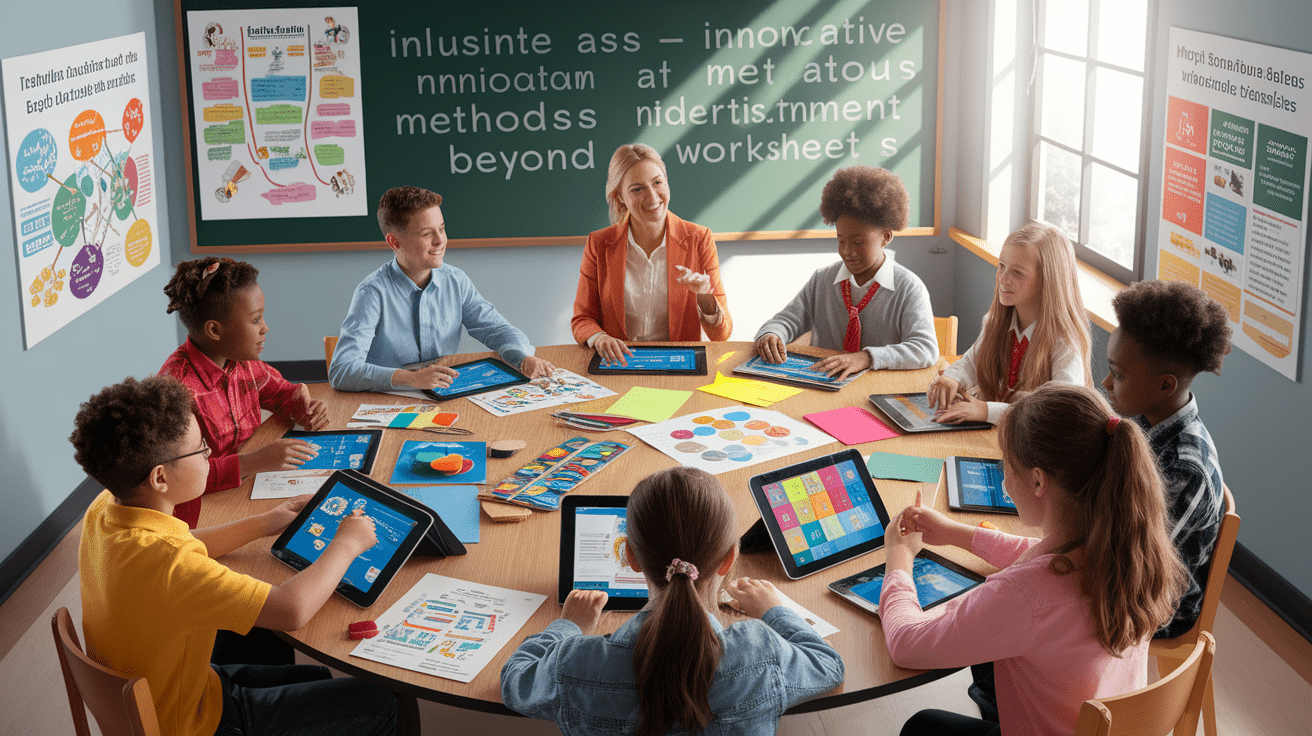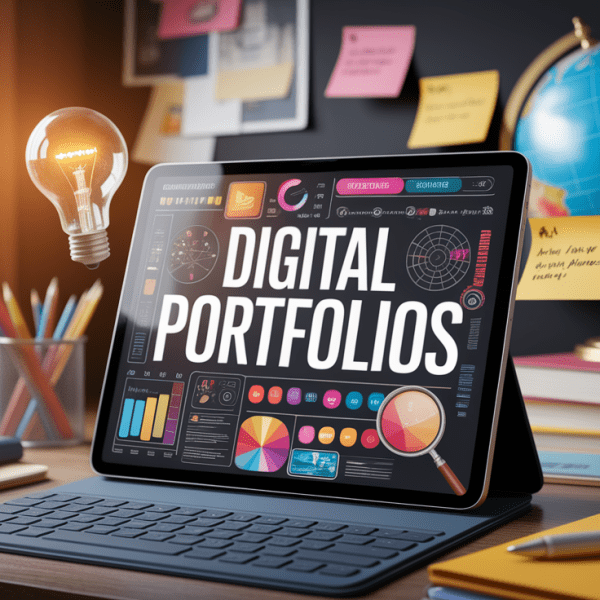Introduction – Ditch the Dull Worksheet
Picture this: It’s Monday morning, and you’re watching your students drag themselves through yet another worksheet. Their eyes glaze over as they mechanically fill in blanks, their creativity stifled by rows of identical problems. Sound familiar? You’re not alone! Traditional assessments like worksheets often focus on rote memorization and narrow skill demonstrations, limiting deeper understanding and genuine student engagement.
But here’s the exciting news – there’s a whole world of creative assessment ideas waiting to transform your classroom! Modern educational strategies prioritize engagement through active participation, real-world application, and formative feedback loops to better align with 21st-century learning goals. When you move beyond traditional tests and quizzes, you open doors to authentic learning experiences that make assessment more fun and less stressful for students.
Ready to revolutionize how you measure student understanding? Let’s explore how to seamlessly integrate engaging assessment strategies into your lesson plans and watch your students thrive!
Why Move Beyond Worksheets
Let’s be honest – worksheets have their place, but when they become our go-to assessment tool, we’re missing incredible opportunities to truly understand what our students know and can do. The overreliance on worksheets creates several challenges that limit both teaching effectiveness and student engagement.

The Limitations of Traditional Assessment
Traditional worksheet-based assessments often fall short because they:
- Focus on memorization over application – Students can fill in answers without truly understanding concepts
- Provide limited insight – A completed worksheet doesn’t show thinking processes or problem-solving strategies
- Create feedback delays – By the time you grade and return worksheets, the learning moment has passed
- Miss diverse learning styles – Not all students demonstrate knowledge effectively through written responses
- Lack real-world connection – Students struggle to see relevance in isolated skill practice
The Power of Authentic Assessment
When we embrace authentic assessment methods, we create opportunities for students to demonstrate their learning in meaningful, engaging ways. Research shows students find tasks more engaging when they understand the target knowledge and its application. Alternative assessment approaches allow us to:
- Observe students applying knowledge to real-world situations
- Gather rich data about student thinking and problem-solving processes
- Provide immediate, actionable feedback
- Accommodate different learning preferences and strengths
- Build critical thinking skills alongside content mastery
Engaging Assessment Methods to Try
Ready to spice up your assessment toolkit? Here are proven interactive evaluation methods that will have your students excited about demonstrating their learning!

Formative Assessment That Actually Engages
Formative assessment doesn’t have to mean pop quizzes and exit tickets. Try these dynamic approaches:
- Digital polling with Kahoot – Transform review sessions into game-show excitement while gathering real-time data on student understanding
- Gallery walks – Post student work around the room and have peers provide structured feedback using observation checklists
- One-minute explanations – Students record brief video explanations of key concepts on their devices
- Collaborative concept mapping – Teams create visual representations of their understanding that reveal misconceptions and connections
Performance Assessment That Showcases Real Learning
Performance assessment allows students to demonstrate skills through authentic tasks. Consider these examples:
- Science investigations – Instead of worksheets about the scientific method, have students design and conduct experiments to solve real problems
- Mathematical modeling – Challenge students to use data analysis to solve community issues like traffic patterns or environmental concerns
- Historical simulations – Students take on roles of historical figures and debate solutions to period-appropriate challenges
- Literary podcasts – Rather than book reports, students create podcast episodes discussing themes and character development
Project-Based Learning Integration
Project-Based Learning (PBL) naturally incorporates assessment throughout the learning process. Students working on long-term projects can demonstrate growth through:
- Digital portfolios using platforms like Google Classroom or Seesaw to document their learning journey
- Peer evaluation sessions where students provide structured feedback on each other’s work
- Self-assessment reflections that help students set goals and monitor their progress
- Community presentations where students share solutions with authentic audiences
Embedding Assessments in Your Lesson Plans
The key to successful assessment integration lies in weaving evaluation seamlessly throughout your lesson planning process. When assessment becomes an integral part of learning rather than an afterthought, both teaching and learning improve dramatically.

Assessment as Learning
This approach empowers students by making them active participants in their learning through:
- Ipsative assessments that track individual progress over time
- Self-assessment opportunities for goal-setting and reflection
- Peer assessments that build collaborative feedback skills
Strategic Placement Throughout Lesson Phases
Understanding the four phases of a lesson plan helps you identify natural assessment opportunities:
Diagnostic Assessment (Beginning)
Start each unit by identifying baseline knowledge through creative methods like:
- Pre-unit journals where students sketch or write what they already know
- Informal interviews during warm-up activities
- Quick digital surveys using tools like Mentimeter
Formative Assessment (During)
Continuously gauge understanding through:
- Thumbs up/down checks with specific questions
- Think-pair-share discussions with structured protocols
- Interactive notebook entries with peer reviews
Performance Assessment (Application)
Let students apply learning through:

- Mini-projects that solve authentic problems
- Role-playing scenarios that require content application
- Creative demonstrations of understanding
Summative Assessment (Culmination)
End units with meaningful evaluation like:
- Portfolio presentations showcasing growth
- Student-led conferences explaining their learning
- Performance tasks that mirror real-world applications
Aligning with Learning Objectives
Effective assessment requires clear alignment with your lesson plan goals and objectives. When students understand what they’re working toward, engagement naturally increases. Create assessment methods that directly measure the skills and knowledge outlined in your objectives.
Best Practices for Effective Student Engagement
Making assessment engaging isn’t just about choosing fun activities – it’s about creating meaningful experiences that motivate students to demonstrate their best thinking. Here’s how to maximize student engagement in your assessment practices:
Design Effective Rubrics
Rubrics are your secret weapon for creating effective rubrics for student presentations and other performance tasks. Great rubrics:
- Use student-friendly language that clearly describes expectations
- Include specific examples of what success looks like at each level
- Focus on learning objectives rather than superficial elements
- Involve students in creation when possible to increase buy-in
Incorporate Choice and Voice
Differentiated assessment recognizes that students have different strengths and preferences. Offer options like:
- Multiple formats (video, presentation, written report, artistic creation)
- Various topics within the same learning standard
- Different collaboration structures (individual, partner, small group)
- Technology integration options based on comfort level
Provide Meaningful Feedback
Meaningful feedback transforms assessment from evaluation to learning opportunity. Effective feedback:
- Focuses on specific learning objectives rather than general praise
- Includes actionable suggestions for improvement
- Highlights strengths to build confidence
- Arrives quickly enough to influence learning
Use Technology Strategically
Digital tools for ongoing assessment can streamline your workflow while engaging students:
- Adaptive platforms like Prodigy adjust math problems as students master concepts
- AI-driven tools provide instant feedback on writing assignments
- Collaborative platforms enable peer feedback and revision cycles
- Documentation tools help students track their own progress
Measuring Impact and Continuous Improvement
How do you know if your engaging assessment methods are actually working? The key lies in systematically measuring their impact and continuously refining your approach based on evidence.
Gathering Evidence of Effectiveness
Look for multiple indicators that your assessment strategies are making a difference:
- Student engagement metrics – Are students more active, asking more questions, taking ownership of their learning?
- Learning outcomes – Do students demonstrate deeper understanding and better retention?
- Feedback quality – Are students providing more thoughtful peer evaluations and self-reflections?
- Time efficiency – Are you gathering better information about student learning in less time?
Implementing Continuous Improvement Cycles
Use these strategies to refine your assessment practices:
- Regular reflection – Set aside time each week to analyze what’s working and what needs adjustment
- Student feedback – Ask students directly about their assessment experiences and preferences
- Peer collaboration – Share strategies with colleagues and observe each other’s assessment practices
- Professional development – Stay current with emerging assessment trends and research
Addressing Common Challenges
Even with the best intentions, you might encounter obstacles. Here’s how to overcome common assessment challenges:
- Time constraints – Start small with one or two new methods rather than overhauling everything
- Grading concerns – Use rubrics and student self-assessment to streamline evaluation
- Administrative expectations – Document how engaging assessments align with standards and improve learning outcomes
- Student resistance – Gradually introduce new methods and explain the benefits to build buy-in
Conclusion – Cultivating a Dynamic Assessment Culture
Transforming your classroom assessment culture doesn’t happen overnight, but every step toward more engaging, authentic evaluation methods makes a difference in student learning and motivation. By moving beyond worksheets and embracing creative assessment ideas, you’re not just measuring learning – you’re actively promoting it.
Remember, the goal isn’t to abandon all traditional methods but to strategically integrate interactive evaluation approaches that provide richer insights into student understanding. When you combine formative assessment, performance assessment, and authentic assessment methods with your existing instructional strategies, you create a powerful learning environment where assessment becomes a tool for growth rather than judgment.
Start tomorrow with one small change – replace a worksheet with a gallery walk, try a digital polling tool, or introduce peer evaluation into an existing assignment. Your students will thank you, and you’ll be amazed at what you discover about their learning when you give them engaging ways to show what they know!




